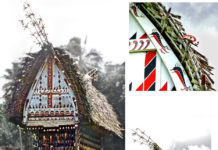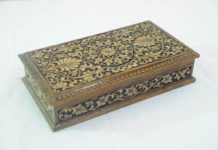Solomon Islanders carve in wood and stone. Popular in tourist markets are copies of sacrificial bowls carved in softwood, stained black with a dye made of plant sap mixed with ground charcoal, or lamp black, and inlaid with mother-of-pearl inlay elements (mostly from Santa Ana and Santa Catalina). Polynesian carvers also use black-stained softwood, with finely plaited Pandanus-leaf wraps (as in Rennell-Bellona). The sale of artefacts has long been, and continues to be, a source of income for some Solomon Islanders. However, wooden items are still carved for domestic use in villages, especially food bowls, canoes and canoe paddles.
Though Solomon Islanders with carving skills are distributed widely throughout the country, carvings for general sale are mostly produced in the Melanesian communities of Marovo Lagoon, Ranonnga, and Santa Ana, and by Polynesians of Rennell and Bellona. Not all of the old techniques are still in use, and new forms are now made, to suit the tastes of visiting Europeans.
Most Marovo carvers work with wood, producing fine bowls and nguzunguzu (traditional war canoe figureheads). Kerosene wood (Cordia subcordata) is most used, with pearl shell inlay as decoration. The work of these carvers in highly polished or stained wood sometimes reveals African influence, at other times simply a new idea. Ranongga carvers are renowned for their stone carvings, while copies of old sacrificial bowls are made in Santa Ana and Santa Catalina. Polynesians of Rennell-Bellona produce small wood-carved items and have adapted styles and processes to produce larger wooden carvings such as posts.
The pearly inner shell of Nautilus pompilius, is used throughout Solomon Islands as inlay to decorate wooden items, including canoes. Pieces of this shell inserted with adhesive of putty nut (a tree, Parinari) produce a striking contrast to the black-stained or brown wood. Shell inlay techniques are widespread in islands such as Isabel, where inlay and wood carving skills are sustained through projects to decorate church interiors.
The main source of carvings, Marovo, has many artisans, among those more artistic are Basia Dioni, and Humes Namusu, of Chea village.
A nguzunguzu war canoe figurehead with pearl shell inlay, carved in a soft wood and stained black – by Basia Dioni of Chea village, Marovo. (Baines collection).





